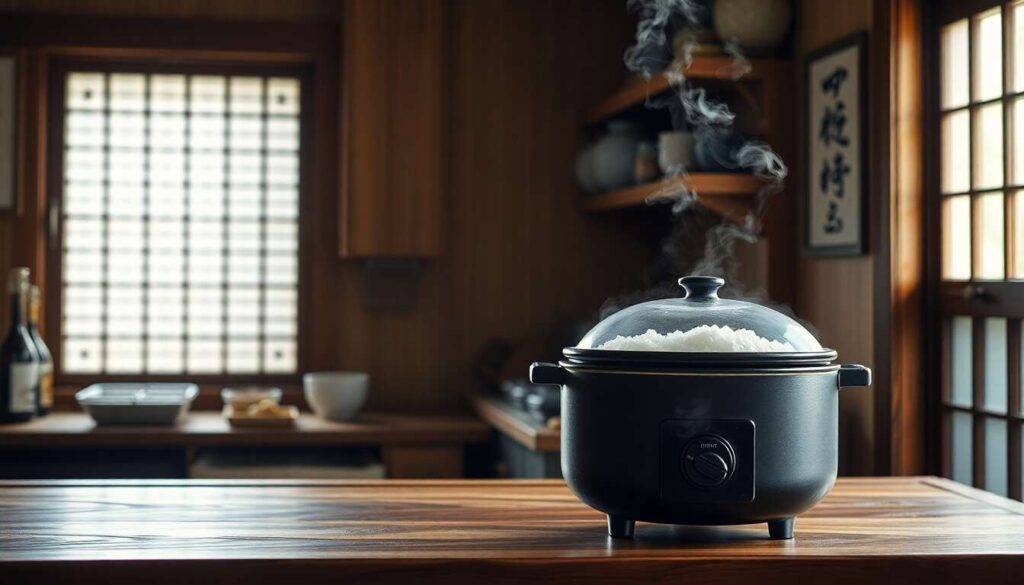Many wonder why the Japanese do not boil their rice as is common in other culinary cultures. In truth, the Japanese method of rice cooking transcends mere technique; it is a refined art perfected over centuries. This article reveals the secrets of this ancestral tradition which emphasizes a respectful cooking approach to rice, thereby maximizing its unique taste and texture.
Understanding The Choice Of Rice: Japonica Variety And Unique Characteristics
The Japonica Rice: The Essence Of The Japanese Meal
When selecting the ideal rice, the Japanese choose the Japonica variety, known for its slightly sticky texture that enhances the dining experience. Unlike long-grain varieties, Japonica is perfect for dishes where rice takes center stage. Its primary characteristic is that it becomes tender and fluffy when cooked, an essential quality for Japanese cuisine.
The Reasons Behind This Preference
Several factors explain the popularity of Japonica rice in Japan:
- Sticky Texture: essential for sushi and other Japanese specialties.
- A roundness on the palate that complements various dishes.
- A rich historical and cultural heritage intertwined with Japanese gastronomy.
With these preferences in mind, it is easier to understand why a specific variety like Japonica seamlessly fits into Japanese culinary traditions.
The Culture And Tradition Surrounding Japonica Rice
Japan has a long-standing tradition in rice cultivation, and Japonica in particular is closely linked to the country’s culinary identity. The historical roots of this rice extend beyond mere sustenance and form part of the cultural heritage, where each grain can be viewed as an embodiment of the unique relationship the Japanese have with this cereal.
With a better understanding of this choice of rice in Japan, it is time to explore what makes the Japanese cooking method so special.
The Unique Qualities Of Japanese Rice
Unmatched Texture
Japanese rice is distinguished by its unique texture, making it incredibly appetizing. By avoiding traditional boiling methods, the Japanese preserve the structure of the grains, ensuring they remain separate yet fluffy. This quality positions Japanese rice as a staple in global gastronomy.
The Secret Lies In Preparation And Cooking
The specificity of Japanese rice extends beyond variety selection. Careful preparation and cooking methods are crucial steps that play an equally decisive role:
- Repeated washing removes excess starch.
- The soaking time is vital for achieving the perfect texture.
These preliminary steps ensure that each grain is at its best during cooking.
Subtle Flavors And An Enriching Experience
By maintaining the original grain structure while providing a round mouthfeel, Japanese rice becomes a champion of subtle flavors. These attributes are essential for being the perfect accompaniment to many traditional Japanese dishes, with this rice often enjoyed on its own.
Today, with these unique aspects in mind, let us delve into the necessary steps for successfully cooking Japanese rice.
Essential Steps For Perfectly Cooking Japanese Rice
The Art Of Washing And Soaking
One key to success lies in the preparation of the rice before cooking. Repeated washing is essential to eliminate excess starch that could weigh down the rice. After this step, soaking allows the grains to hydrate evenly, a crucial aspect for achieving a perfect texture.
Gentle Cooking
Cooking Japanese rice differs from traditional boiling for optimal results. It is usually done over low heat, ensuring even heat distribution. Here’s how:
- Place the rice and water in a pot and bring to a boil.
- Reduce to medium heat to allow the rice to simmer covered.
- Turn off the heat and do not lift the lid immediately, allowing the grains to continue absorbing the remaining steam.
The Resting Phase: An Indispensable Step
After cooking, resting the rice is crucial. It not only allows the flavors to develop further but also ensures that each grain slightly puffs up, offering the best texture during tasting.
Now that we have mastered preparation and cooking, let’s examine the importance of multi-step cooking in Japan.
The Multi-Step Cooking Process: A Well-Kept Secret
A Methodical Approach
The Japanese multi-step cooking method is a process that requires special attention and reflects a systematic approach. This process is not just a technique, but also a means of showing respect for rice by preserving its best qualities. Without the impulsiveness of quick cooking, each step contributes to enhancing the taste and quality of the rice.
The Successive Cooking Steps
Rather than simply boiling the rice, the Japanese employ multiple subtleties that grant great importance to how each grain is cooked:
- Beginning with a gentle boil.
- Then simmering at a lower temperature.
- Followed by resting under a lid.
The Importance Of Timing And Temperatures
Controlling timing and temperatures is crucial for achieving perfect rice. A careful attention to these details ensures that the grains are incredibly fluffy while retaining their integrity. This method allows for a tasting experience that highlights the richness of aromas.
With these secrets in hand, let’s explore how to apply this method in our own kitchens.
Best Practices For Cooking Japanese Rice At Home
Recommended Equipment
To achieve results similar to those of Japanese cooks, several pieces of equipment can facilitate the process:
- A rice cooker: specifically designed to cook rice to perfection.
- A pot with a snug-fitting lid: for optimal heat distribution.
- Utilizing both a wooden spoon and a sieve for washing.
Cooking Tips To Keep In Mind
Even without specialized equipment, some tips can help ensure successful cooking of Japanese rice:
- Respect the rice-to-water ratio, typically 1:1.2 for Japonica.
- Avoid lifting the lid during cooking to retain steam.
- Feel free to adjust the resting time after cooking according to the desired texture.
Experimenting With Patience
The perfect preparation of Japanese rice is a matter of experimentation and patience. Taking the time to understand your own equipment and adjusting techniques as necessary guarantees flavorful and authentic rice.
Having mastered the preparation, let us turn our attention to tasting and storing rice to extend the culinary pleasure.
Tasting And Storing Japanese Rice: Practical Tips
Preparing Rice For Maximum Tasting Pleasure
Once the rice is cooked, how it is served can further enhance the culinary experience. To maximize tasting pleasure:
- Serve the rice immediately after resting to enjoy its optimal texture.
- Use traditional rice bowls for a more authentic presentation.
- Pair with accompaniments that enhance its subtle flavors.
Storage Techniques
To prolong rice storage and avoid waste, use these tips:
- Store in an airtight container to preserve moisture.
- Refrigerate promptly and reheat using steam to maintain texture.
- It can be frozen in portions for later use.
Reheating: Preserving Quality
To reheat rice without losing quality, steaming is recommended. The microwave is also effective when the rice is covered with plastic wrap or a suitable lid to prevent drying out.
With these tips in mind, anyone can enjoy authentic, high-quality Japanese rice at home.
Embracing the Japanese method of cooking rice invites a rediscovery of each grain in a new light. By applying these techniques, one moves closer to an authentically Japanese experience that blends patience and expertise to elevate a staple food. Whether for a daily meal or a special occasion, the meticulousness of this approach transforms rice into a culinary masterpiece, honoring a rich and profound tradition.







